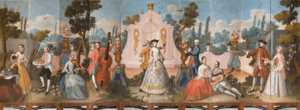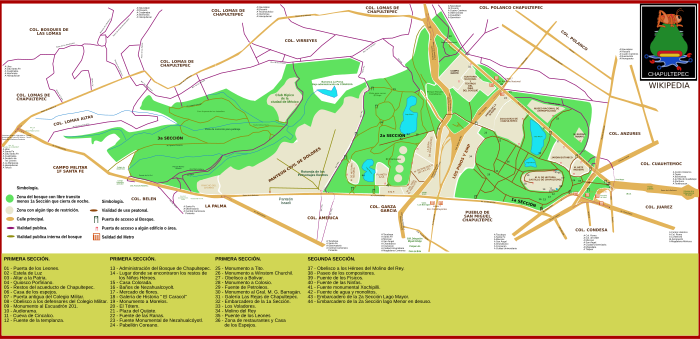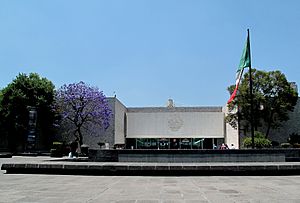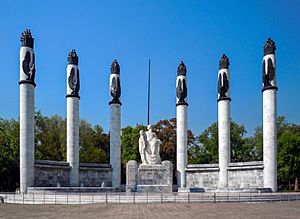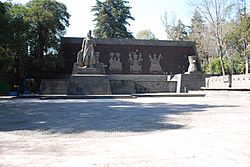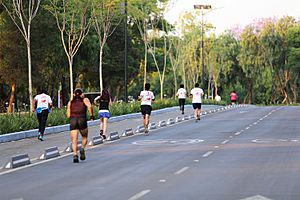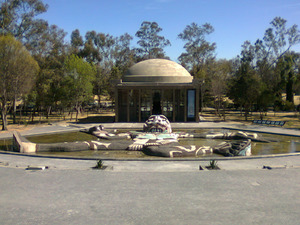Chapultepec facts for kids
Quick facts for kids Chapultepec |
|
|---|---|
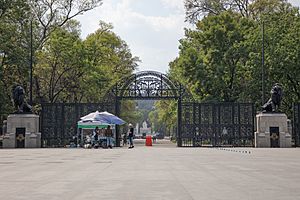
Puerta de los Leones, the main entrance into Chapultepec
|
|
| Lua error in Module:Location_map at line 420: attempt to index field 'wikibase' (a nil value). | |
| Type | Urban park |
| Location | Miguel Hidalgo, Mexico City, Mexico |
Chapultepec, often called the "Bosque de Chapultepec" (Chapultepec Forest), is one of the biggest city parks in Mexico City. It covers a huge area of over 686 hectares (1,695 acres). The park is built around a large rock called Chapultepec Hill. It acts like a giant "lung" for Greater Mexico City, helping to keep the air clean.
People have lived in and around Chapultepec for a very long time, even before the Aztecs. It was a special place for Aztec rulers to relax. Later, during the colonial period, Chapultepec Castle was built here. This castle became the official home for Mexico's leaders until 1934. After that, the presidential residence moved to Los Pinos, another part of the park.
Chapultepec Forest is divided into four main parts. The first section is the oldest and most popular. It has many famous attractions, like the castle, the Chapultepec Zoo, the Museum of Anthropology, and the Rufino Tamayo Museum. About 15 million people visit this section every year! Because so many people visit, the park needed big repairs. These repairs started in 2005 and finished in 2010.
Contents
History of Chapultepec Park
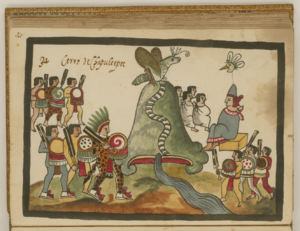
People have lived in the Chapultepec area since ancient times. The first known group was the Toltecs. They called the area "grasshopper hill," which later became "Chapoltepēc" in Nahuatl. This means "at the grasshopper hill." Archeologists have even found parts of a Toltec altar on top of the hill. Later, people from the Teotihuacan culture lived here. When the Aztecs arrived, the Tepanecas of Azcapotzalco were living in the area.
When the Aztecs took control of the Valley of Mexico, they saw Chapultepec Hill as a very important and holy place. They used it to bury the ashes of their rulers. The springs in the area also provided fresh water for their capital city, Tenochtitlan. Over time, only the Aztec rulers and religious leaders were allowed to visit this special retreat. In the 1420s, the ruler Nezahualcoyotl built the first palace here. Moctezuma II created ponds for exotic fish and to store water. He also planted trees and plants from all over the Aztec Empire. In 1465, Moctezuma I ordered his picture to be carved into a rock at the bottom of the hill. He also built the Tlaxpana aqueduct, which was three kilometers long.
During the Spanish conquest, one of the last battles between the Spanish and the Aztec ruler Cuauhtémoc happened at Chapultepec Hill in 1521. Soon after, the Franciscans built a small church over the old Aztec altar. Hernán Cortés took Chapultepec for himself. But in 1530, King Charles V said the area belonged to Mexico City and should be open to everyone. The Spanish continued to use the Aztec aqueduct. However, in 1771, a new aqueduct was needed for the growing city. The Chapultepec aqueduct carried water from the park's springs to the south of the city. It had over 900 arches and was almost four kilometers long. In 1785, the old church was taken down to build Chapultepec Castle. The hill and forest became a summer home for the colonial viceroys. The area was then closed off to the public and used for fancy parties.
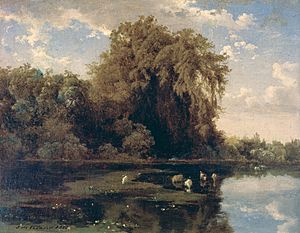
After Mexico became independent in 1821, the Castle became the official home for Mexico's leaders. Some leaders, like Emperor Maximilian I, made the castle and the forest even more beautiful. The hill was also the site of the Battle of Chapultepec in 1847. This battle was fought between Mexican and U.S. soldiers. A group of young cadets were at the Castle when it was attacked. Near the end of the battle, six of them bravely chose to jump to their deaths from the castle rather than surrender. These six are known as the "Niños Héroes" (Child Heroes). A monument honors them near where they fell. The castle remained the president's home until 1940. Then, it became a museum.
Since then, the park has grown twice. The second section was added in 1964, and the third section ten years later. The park has focused on keeping the area well-maintained. In 2005, the first section was closed for big renovations. When it reopened, rules for selling things were much stricter. The park continues to work on keeping its environment healthy.
What Makes Chapultepec Special?
Chapultepec Park is the second largest city park in Latin America. It covers over 686 hectares (1700 acres). It's one of the biggest and most visited city parks in the world, like Central Park in New York City. The name "Chapultepec" means "at the grasshopper hill" in Nahuatl. This refers to a large rock in the first section of the park. Long ago, this area was a forest outside the city. Today, it's completely inside Mexico City, surrounded by busy areas. The park has three sections. The first and oldest section is fenced and closed at night. The other two sections stay open. The park has nine museums, amusement parks, paths, sculptures, lakes, and fountains. The famous Paseo de la Reforma road runs along much of the park.
One of the park's most important jobs is to be a green space for Greater Mexico City. It's called one of Mexico City's "lungs" because its trees produce oxygen. It's also a large unpaved area that helps refill underground water sources. It helps cool the city and attracts rain. Many migratory birds from Canada, the U.S., and other parts of Mexico find refuge here. These include the Cooper hawk and wild ducks. You can find many bird species here, including native ones like the Berylline Hummingbird. There are also over a dozen types of reptiles and amphibians. Some animals, like the axolotl, are in danger of disappearing. The park is home to many Montezuma cypress trees, called "ahuehuetes." Some of these trees are hundreds of years old. Many were planted by the Aztecs. The city estimates it needs about MXN$100 million each year to keep the park's environment healthy.
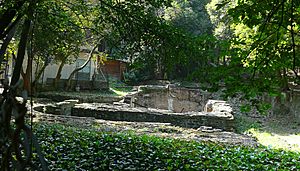
For people living in Mexico City, the park is important for its history and culture, as well as being a green space. The area has signs of human life from as far back as the Toltecs. There are ruins from ancient times to the colonial period. Archeologists have found tombs, a Toltec altar, parts of a colonial aqueduct, and paths linked to Nezahualcoyotl. One famous spot is the Baths of Moctezuma, which were a system of tanks and canals built by the Aztecs. The Instituto Nacional de Antropología e Historia lists the park and Chapultepec Castle as Mexican heritage sites. They even suggested it become a World Heritage Site in 2001.
The park gets about 15 million visitors every year, with over 250,000 daily visits. Sundays are the most popular day because museums are free. Visitors can spend the whole day exploring, picnicking, or grilling. Even though it's popular locally, many foreign visitors only see a small part near the museums. It's easy to get to the park by public transport. The Chapultepec metro station and Constituyentes metro station offer easy access.
First Section: The Heart of the Park
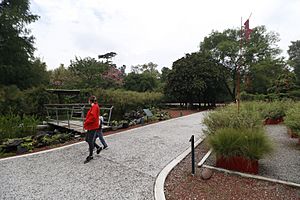
The first section is the oldest and most visited part of Chapultepec Park. It's the most developed area and has a fence around it. This section covers about 274 hectares (677 acres), with much of it being green space. It holds most of the park's famous attractions. These include the Lago Menor (Small Lake), the Nezahuacoyotl Fountain, and the Quixote Fountain. You can also find monuments like the Altar a la Patria and the Obelisco a los Niños Héroes. The best-known museums are here, such as Museo Nacional de Historia-Chapultepec Castle, the National Museum of Anthropology, and the Museo de Arte Moderno (Modern Art Museum). The Chapultepec Zoo is also in this section. All these places are connected by paved paths, some with names like the Avenue of the Poets. This path has statues of famous writers and very old trees.
This section also has Chapultepec Hill, which gave the park its name. It's a volcanic rock formation with small caves. "Chapultepec" means "grasshopper hill" in Nahuatl. This hill was special to ancient cultures, from the Toltecs to the Aztecs. Remains of a Toltec altar have been found at the top. Only Aztec emperors and important people were allowed on the hill.
After the Spanish arrived, a small chapel was built on the hill. In the 18th century, the Spanish built Chapultepec Castle here as a summer home. After Mexico became independent, the Castle became the official residence for Mexico's leaders, including Emperor Maximilian. He had the Paseo de la Reforma built to connect the castle to the city center. The castle and its gardens were made bigger and more beautiful. In 1940, the president's home moved to Los Pinos. The castle then became the National Museum of History. The museum has twelve rooms open to the public, many looking as they did when Emperor Maximilian lived there. It also has furniture, art, and items from important Mexican figures like Miguel Hidalgo y Costilla and Benito Juárez. There are also murals by famous artists like José Clemente Orozco. At the bottom of the hill is a large monument to the Niños Héroes. These six young cadets bravely fought against invading US troops in 1847. The monument has six marble columns around a tomb with their remains.
The Chapultepec Zoo is the most visited attraction in the park. About half of all park visitors come to the zoo. It was started by biologist Alfonso L. Herrera and opened in 1924. He wanted to bring back the zoo tradition of the Aztec emperors. He started with Mexican animals and then added others from around the world. In 1975, the zoo got two pandas from China. Since then, at least eight panda cubs have been born here, making it the first place outside China to breed them. From 1992 to 1994, the zoo was completely updated. Now, animals are grouped by their natural habitats. Important Mexican animals here include the volcano rabbit, the Mexican wolf, and the axolotl. Today, the zoo has 16,000 animals of 270 species. They are divided into four habitat sections: tropical forest, temperate forest, desert, and grassland. About one-third of the animals are native to Mexico.
Most museums in the first section are along Paseo de la Reforma. The most famous is the National Museum of Anthropology. It's considered one of the world's most famous archeological museums. The current building was designed in the 1960s. It has 25 exhibit halls with sections for each major ancient Mexican civilization, like the Aztec, Maya, Toltec, and Olmec. The collection is huge, and many visitors spend hours exploring it. There are also special temporary exhibits. The Rufino Tamayo Museum is also on Paseo de la Reforma. Its main collection focuses on Rufino Tamayo's art, but it also has art from other Mexican and foreign artists that Tamayo donated. He collected important 20th-century art from artists like Andy Warhol and Picasso.
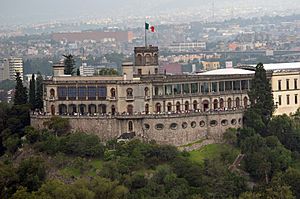
The Museo de Arte Moderno (Museum of Modern Art) is also on Paseo de la Reforma. It has temporary exhibits and a sculpture garden. It holds one of Mexico's best collections of 20th-century modern art. Artists like Frida Kahlo and David Alfaro Siqueiros have works here.
The Casa de Cultura Quinta Colorada was once a home for park rangers. It's built in a European style. Today, it hosts cultural events and has a small planetarium.
At the foot of Chapultepec Hill is the Museo del Caracol (Snail Museum). This museum tells the history of Mexico in a winding building shaped like a snail.
The Luis Barragán House and Studio was the home of architect Luis Barragán. It has been kept almost exactly as it was since 1948. It also shows artworks from the 19th and 20th centuries.
One of the most popular spots in the first section is the Lago Menor (Smaller Lake). Visitors can rent paddleboats and rowboats here. This lake was created in the late 1800s when the park was redesigned. The Casa del Lago was built at the same time. It's now a restaurant that serves different kinds of food.
Besides the lake, there are many large fountains. The Quixote Fountain is surrounded by benches with images of Don Quixote. It has statues of Quixote and Sancho Panza. The Fuente de las Ranas (Fountain of the Frogs) was made in Spain in the 1920s. The Nezahualcoyotl Fountain, opened in 1956, has a nine-meter-tall statue of the Aztec ruler.
The first section has many different kinds of trees. The most common are the Montezuma cypress, called "ahuehuetes." Many are hundreds of years old. One dead tree, called the Ahuehuete of Moctezuma, is a monument to the area's history. It's 50 meters tall. Another living tree, El Tlatoani, is over 700 years old and the oldest in the park. There are also sequoias, cedars, pines, and other trees.
Los Pinos has been the official home of Mexico's presidents since 1941. It's inside the park, but the public cannot enter it. The buildings are white stucco. You can see them from Molino del Rey, an old mill that was a battle site in 1847.
The National Auditorium is one of Mexico City's main venues. It hosts concerts and dance shows. Singers from Mexico and other countries perform there all year. The park also has cultural events. One is the performance of Swan Lake on a stage in Lago Menor. This show has been happening since 1978 during warmer months. Night tours by train are popular around Christmas, when many attractions are lit up. The Ballet Folklórico de México also performs at Chapultepec Castle sometimes.
Second Section: Fun and Nature
The second section of the park was created in 1964. It was built on old farmlands. This section is separated by the Anillo Periférico road and covers about 160 hectares. It's not as developed as the first section, but it's also for fun activities. Lago Mayor (Larger Lake) is partly in this section. This part of the lake has the Monumental Fountain, the biggest in Latin America. It's surrounded by restaurants and cafés. Nearby are the Compositores and Xochipilli fountains.
This area has jogging trails and places for yoga and karate. About 1,000 people come here every day to exercise. The jogging trails were made longer in the late 2000s.
One part of this section used to have the Feria de Chapultepec amusement park. It was near Lago Mayor. The park could hold 15,000 people and had about two million visitors each year. It had several roller coasters. The park closed in 2019 after an accident. A new park called Atzlan Parque Urbana will replace it. This new park will be greener and focus more on live shows about Mexico City. It will have some rides and is expected to open soon.
This section also has museums like Papalote Museo del Niño and the Museo de Historia Natural (Natural History Museum). El Papalote Museo del Niño is an interactive children's museum. It encourages kids to touch and play with the exhibits.
The Cárcamo de Dolores is a special water structure in this section. It was built between 1942 and 1952 to bring water to Mexico City from the Lerma River. The parts open to the public include a building with an orange dome and a fountain with an image of Tlaloc, the Aztec rain god. The main building has snake heads on its corners and a mural by Diego Rivera called El agua: origen de la vida (Water: Origin of Life).
In 2010, the second section of the park was improved. This included renovating the jogging track, the Tlaloc Fountain, and the Cárcamo de Dolores building. These works together form the Museo Jardín del Agua (Water Garden Museum). Many dead trees were removed, and about 800 new ones were planted. There is also a carousel in this area.
Third Section: Wild Nature Preserve
The third section of the park is on the west side of the second section. It opened in 1974. It's the least developed and least visited part. It's full of trees and wildlife. While some activities like archery and horseback riding happen here, this area is mainly a natural preserve. It protects different kinds of plants and animals, like snakes and lizards. In 1992, it was declared a Protected Natural Area.
Fourth Section: The Newest Addition
The fourth section is the newest part of the park. It's the westernmost zone and opened in 2021. It covers 74 hectares. This land was given to the park by the SEDENA (Mexico's Ministry of National Defense).
Images for kids
-
Chapultepec Hill as depicted in the Tovar Codex. The scene shows the Aztec tlatoani Huitzilihuitl and Tepanecs (right) about to be defeated by the warriors of Xochimilco and Chalco (left).
-
Biombo. Sarao [party] in a garden of Chapultepec, anonymous painter, ca. 1780-1790, Mexico City. National Museum of History of Chapultepec Castle.
-
An 1875 painting, Ahuehuetes en Chapultepec, by José María Velasco Gómez depicting the ahuehuetes by the lake in Chapultepec. It's possible this is a view from Chapultepec Castle.
-
One of the Baths of Chapultepec
-
Path through the botanical garden in the first section
-
Chapultepec Castle on top of Chapultepec Hill
See also
 In Spanish: Chapultepec para niños
In Spanish: Chapultepec para niños


